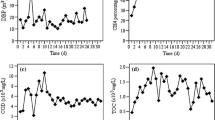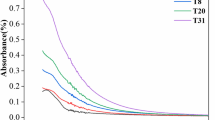Abstract.
The chemical composition of waste-material-derived dissolved organic matter (DOM) was characterized by chemolytic analyses and 1H, 13C and 31P nuclear magnetic resonance (NMR) spectroscopy. Dissolved organic matter was extracted by water from an aerobic fermented urban waste compost, a sewage sludge and a pig slurry and then fractionated using the XAD-8 method. The amount of water-extractable dissolved organic carbon (DOC) ranged from 3% in the sewage sludge to 22% in the pig slurry. Dissolved organic matter isolated from pig slurry was equally distributed between hydrophilic and hydrophobic DOC, whereas in the sewage-sludge-derived material the hydrophobic fraction was predominant. Dissolved organic C from the urban waste compost was mainly within the hydrophilic fraction. Wet-chemical analysis and 1H- and 13C-NMR spectra showed that both DOM fractions from the urban waste compost were low in neutral, acidic and amino sugars as well as in lignin-derived compounds. In turn, the materials were rich in low-molecular-weight aliphatic compounds. The chemical structure of both fractions is probably the result of the intensive transformation of urban waste compost during its fermentation. The hydrophilic fractions of DOM from sewage sludge and pig slurry contained considerable amounts of carbohydrates but were also rich in low-molecular-weight aliphatics. The respective hydrophobic fractions had the largest contents of CuO-extractable phenols which may in part derive from sources other than lignin. By contrast with the other materials, the hydrophobic fraction from the pig slurry seemed to contain polymeric rather than low-molecular-weight material. The 31P-NMR spectrum of the hydrophilic DOM fraction from urban waste compost did not show signals of inorganic or organic P compounds while the spectrum of the hydrophobic fraction revealed traces of monoester P, diester P, and orthophosphate. 31P-NMR spectroscopy suggested that both the hydrophobic and hydrophilic fractions from pig slurry did not contain organic P. The hydrophilic DOM fraction from sewage sludge contained orthophosphate, organic monoester P and a little pyrophosphate. The hydrophobic fraction contained mainly organic diester P and smaller amounts of teichoic acids and organic monoester P. Considering that water-soluble fractions of urban waste compost contained no easily plant-available P and a low content of labile organics, we conclude that this material contains less labile nutrients and is more refractory than the soluble constituents of pig slurry and sewage sludge.
Similar content being viewed by others
Author information
Authors and Affiliations
Additional information
Electronic Publication
Rights and permissions
About this article
Cite this article
Gigliotti, G., Kaiser, K., Guggenberger, G. et al. Differences in the chemical composition of dissolved organic matter from waste material of different sources. Biol Fertil Soils 36, 321–329 (2002). https://doi.org/10.1007/s00374-002-0551-8
Received:
Accepted:
Issue Date:
DOI: https://doi.org/10.1007/s00374-002-0551-8




